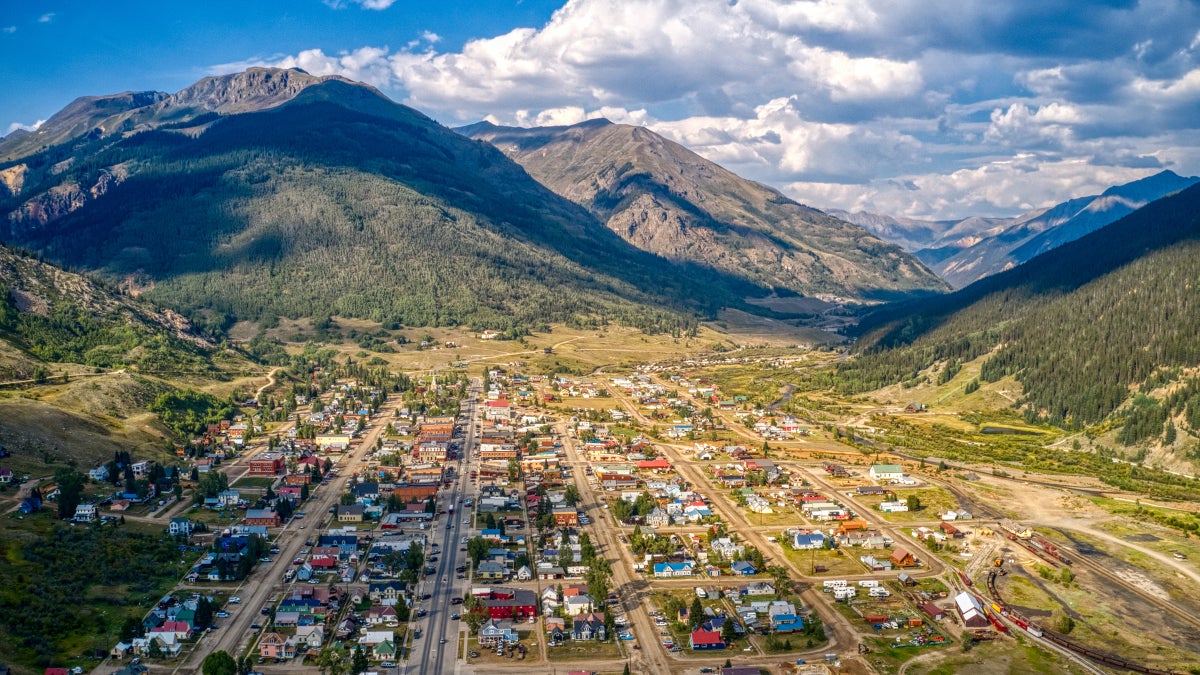
Bigger is not always better. While we spend plenty of time oohing and ahhing over larger mountain towns like Boulder or Chattanooga, there are dozens of smaller hamlets with fewer than 6,000 full-time residents that offer the right combo of amenities and quick access to some of the best spots for outdoor recreation in the country. Here are my favorite small adventure towns across the United States, from minuscule hiking and climbing outposts to bustling ski towns.
Bethel, Maine
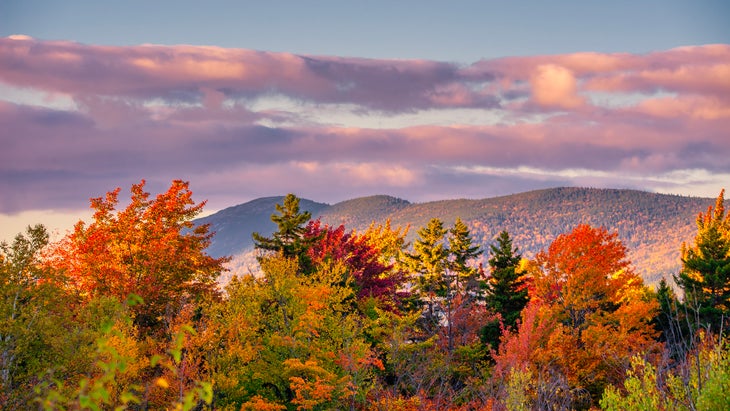
Population: 2,730
Why I Love It
Bethel is the kind of town that makes you consider relocating. Tucked into Western Maine’s Lakes and Mountains region, the village itself is super walkable with an eclectic array of restaurants, while being surrounded by public land, from the peaks that make up the expansive White Mountain National Forest to the less-intimidating Community Forest trails accessed directly from town.
The slow-moving Androscoggin River passes through the village (prime tubing in the summer) and an ever-growing network of singletrack is attracting more and more mountain bikers.
Oh, and Bethel is flanked by two ski resorts. Sunday River is the larger of the two, with more than 2,000 feet of vertical and 750 acres of terrain (not to mention a couple of heated lifts), while Mt. Abram is the mom-and-pop ski hill we all wish we had in our backyard, with $39 lift tickets every day, a friendly uphill policy, and a solid mix of terrain to keep it interesting.
Signature Adventures
Most people come to Bethel to ski Sunday River. If you’re looking for a challenge, head to Oz, a zone loaded with steep double black runs, or take Lollapalooza to Blind Ambition, an expansive gladed run on the edge of Jordan Bowl. Bring your mountain bike during the summer. Mt. Abram has lift-served terrain, but you can hit a number of trails directly from the edge of town. Helix is a fun, flowy three-mile loop in the center of the Bethel Village Trails on the south side of the village.
Where to Eat
Mountain Social has a genius cocktail menu, as well as a seafood chowder that hits just right on a cold winter night. If you’re looking for something more casual, Steam Mill Brewing has burgers and a rotating New England IPA on tap.
Where to Stay
The Bethel Resort will put you on the southern edge of the village, within walking distance of restaurants, and direct access to some of the town’s most loved mountain bike trails (from $126 per night).
Stowe, Vermont
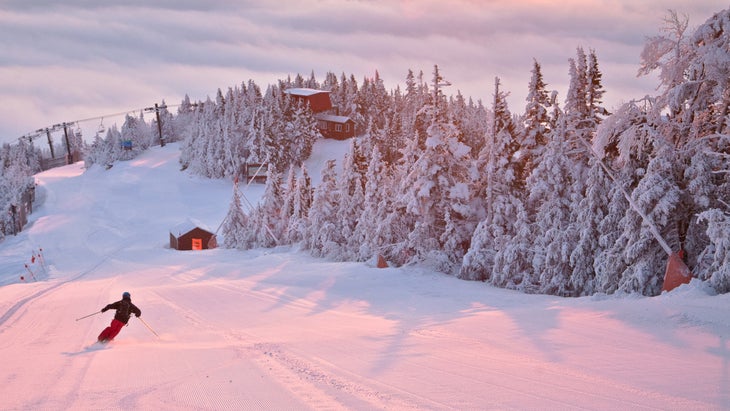
Population: 5,230 or 745
Why I Love It
Quite simply, Stowe is the East Coast’s best ski town, especially this winter as Stowe Mountain Resort has enjoyed 329 inches of snow (and counting) at the time I’m writing this article, and then you have the New England charm of the village itself, with its steeples, covered bridges, and brick federal architectural style. And all of this sits in the shadow of the massive Mount Mansfield State Forest and Smugglers’ Notch State Park.
Not cool enough yet? How about an aggressive and progressive local population that’s worked to preserve more than 4,000 local acres for public use while building out a growing system of singletrack and nordic trails that can be accessed straight from town. Is Stowe still a sleepy hamlet tucked into the hills? Yes and no. The village still feels small, but it can be expensive, and it can get crowded, but that’s the proverbial price you pay for being the best ski town on the East Coast.
Signature Adventures
In the winter, you’re obviously skiing Stowe, which is one of the East’s best resorts, with more than 2,000 vertical feet of drop, and 653 skiable acres split between two mountains: Mount Mansfield and Spruce Peak.When the snow melts, combine a slice of the Long Trail and the Hazelton Trail for an eight-mile loop that climbs the 4,393-foot Mount Mansfield via a 2,000-foot climb that includes some ladders and scrambling before reaching the treeless summit, where you can see the surrounding Green Mountains and the White Mountains in New Hampshire.
Mountain bikers should pedal the Stowe Recreation Trail, a six-mile paved path along the What River, to access Cady Hill Forest, Stowe’s signature trail network with 12 miles of purpose-built singletrack. Make sure you hit the mile-long Florence, considered by many the best flow trail in the northeast. And listen, everyone should make a point to visit Stowe during fall, when the weather is crisp and the hardwoods are popping off in a barrage of reds, yellows, and golds.
Where to Eat
Doc Ponds is incredibly hip, incredibly good, and incredibly crowded, but get on the waitlist and when it’s your chance, order the Vermont cheddar fritters and their smash burger and listen to the DJ spinning from a wall of vinyl. And if you’re in Vermont, you have to stop by the Alchemist and pick up a four pack of the beer that put the brewery on the map, Heady Topper.
Where to Stay
Stowe has resorts attached to the ski hill and quaint bed and breakfasts, but check out the new cabins and lodge rooms at Outbound Stowe a few miles outside of town, with direct access to Stowe’s Recreation Path. The lodge has its own bar, pool, and hot tub and a grassy lawn overlooking the West Branch of the Little River (from $151 per night).
Silverton, Colorado
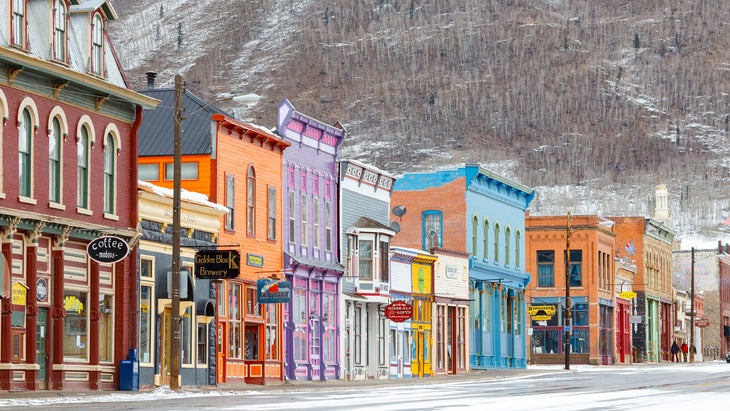
Population: 713
Why I Love It
Sitting at 9,300 feet in elevation, Silverton is a former gold and silver mining town that has found new life as a basecamp for outdoor adventure, thanks to the surrounding San Juan Mountains—a hotbed of skiing in the winter and alpine adventure in the summer. If you’re standing in downtown Silverton, you’re within and 15 miles of seven of Colorado’s 14,000-foot summits.
The entire town is a National Historic Landmark with buildings erected in the late 1800s that still retain their Wild West vibe. Greene Street, the main road through the heart of town, is the only paved street in the municipality. I’ve visited Silverton during the winter, on my way to ski the backcountry terrain in the San Juan mountains, but I’m dying to get back in the summer and early fall to check out the growing network of mountain bike trails and see the aspens surrounding town turn gold.
Signature Adventures
Experience the best of the San Juans in summer by hiking the Highland Mary Lakes Trail, located in the Weminuche Wilderness of the San Juan National Forest. The eight-mile out and back passes through meadows packed with wildflowers before delivering you to a trio of high-alpine lakes that are known to house rainbow, cutthroat, and brook trout. The hike tops out at 12,000 feet in elevation, but you can climb higher by picking up the Continental Divide Trail above the lakes.
The local bike club, the Silverton Singletrack Society, is in the process of building out 30 miles of singletrack in a system called Baker’s Park that you can pedal to from town. The first six-mile loop has just opened, offering a steep climb before releasing you to a 1,000-foot, flowy descent.
If you have the skillset, I highly recommend skiing Silverton Mountain, which is like no other ski “resort” in the country. A single chairlift rises from a warming hut, from the top you can skin out to a cornucopia of backcountry lines, all of which demand expert-level skiing. If that’s not enough terrain, Silverton Mountain also offers heli-bumps from the top of the chairlift.
Where to Eat
Avalanche Brewing has great IPAs as well as a full menu, from cauliflower tacos to pizzas loaded with sausage and bacon.
Where to Stay
The Wyman Hotel has 15 modern rooms in a multi-story building that once housed a gas station, ballroom, and lodge hall. The hotel sits in the heart of downtown and every booking comes with a $10 drink credit in the lobby bar (private rooms from $176 per night; bunks in the 10-bed bunk room from $75 per night).
Highlands, North Carolina
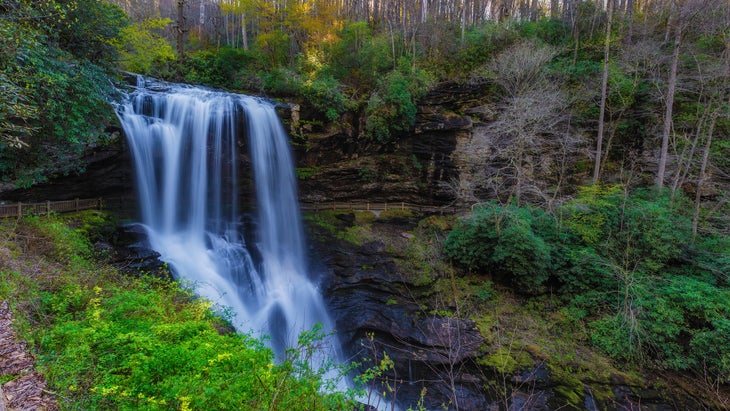
Population: 1,110
Why I Love It
Highlands, which is one of the highest incorporated towns east of the Mississippi (elevation: 4,118 feet), has been a mountain escape since the late 1800s, originally attracting wealthy travelers who flocked to the village for its clean air and pristine surroundings.
People today show up for the same reasons, and Highlands has grown into a cultural hub of the mountains, with a surprisingly robust art and culinary scene given its small footprint. Main Street is bustling with shops, galleries and restaurants, while the surrounding Nantahala National Forest offers fast access to hiking trails, mountain lakes, and waterfalls.
Signature Adventures
Hiking Whiteside Mountain, a 4,903-foot peak named after the sheer, granite face that rises to its summit, is the must-do adventure close to town. The two-mile Whiteside Mountain Trail forms a loop that delivers you to the edge of this 700-foot cliff, one of the tallest in the eastern U.S.
You can actually drive your car behind Bridal Veil Falls, just outside of town, but for a more adventurous waterfall, head to Bust Your Butt Falls, a swimming hole just off Highway 64 on the Cullasaja River with a jumping rock and natural water slide at the base of the falls.
Where to Eat
You can’t turn around without stumbling into another fancy (and pricey) restaurant in Highlands, but I like Mountain Fresh Grocery for its to-go sandwiches and snacks that hit the spot on big hikes.
Where to Stay
Highlands has no shortage of high-end hotels and resorts, but I like the new Outpost Inn, a 14-room motel that was recently renovated into a boutique stay where each room has its own typewriter and turntable with record collection (from $189 per night).
Kanab, Utah

Population: 5,200
Why I Love It
You can’t beat Kanab’s location. Tucked into the desert of southern Utah, just north of the Arizona border, Kanab sits within striking distance of some of the Southwest’s most iconic landscapes. Bryce Canyon National Park is an hour north, Zion National Park is 45 minutes west. If you’re looking to take a dip, Lake Powell is an hour east, and drive two hours south and you’ll hit the North Rim of the Grand Canyon.
The town itself is steeped in Hollywood history, as more than 200 Westerns were filmed in the canyons around town. Kanab itself has a bit of a Moab vibe (think adobe buildings and streets sprawling through the desert floor) but it’s far sleepier than its gateway cousin, and in my opinion, has a much better culinary scene.
Signature Adventures
So many parks, so little time. For something unique, head to Coral Pink Sand Dunes State Park where you can sand-board the 75-foot tall dunes, made of grains of quartz coated with iron oxide, giving them a pink hew. You can rent sand boards or sleds from the visitor center at the park ($25 per board).
Hike Wire Pass to Buckskin Gulch, considered the longest slot canyon in America. The Wire Pass Trail is the fastest way into the gorge, a 3.4-mile round trip that delivers you to the canyon. From there, you can explore up or down the canyon to your heart’s content. The gulch is in the Grand Staircase-Escalante National Monument. You’ll need a permit for the day hike.
Buckskin Gulch is more than 12 miles long, and 200 feet deep at its low point. The walls are never wider than 20 feet during its entire length.
Where to Eat
Kanab is a legitimate foodie destination with a handful of restaurants that punch above the weight of a town this size. If you’re looking for a memorable dinner, head to Sego, where the menu revolves around a series of small plates, from foraged local mushrooms to chili-rubbed beef sourced just across the border in Arizona.
Where to Stay
There are plenty of hotels around town, but spend the night at White Camel, a glamping resort with geodesic domes that have king beds, their own kitchenette, and massive windows overlooking the red rock cliffs (from $170 per night).
Patagonia, Arizona
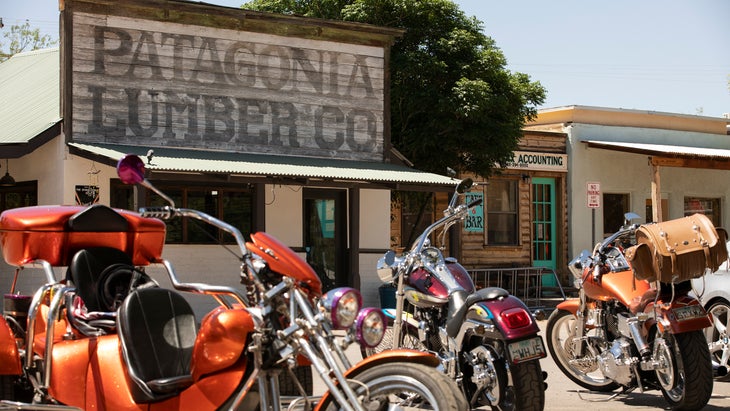
Population: 789
Why I Love It
Start in Tucson, then head an hour south (almost to the Mexican border) and you’ll find tiny Patagonia, a former mining town that’s just starting to transition into a bonafide adventure town. This one-street village is surrounded by 10,000-foot peaks, and sits within striking distance of two state parks—Patagonia Lake and Sonoita Creek. But the real draw here is the myriad of gravel roads that extend from main street into the surrounding hills, traversing an endless sea of desert grassland.
You’ll hear both Spanish and English spoken throughout town, which also sports the tell-tale signs of a modern mountain outpost (like at the coffee bar with weekend food trucks), but is still hanging onto its blue-collar roots (and rooms are still relatively cheap).
Signature Adventures
The 800-mile long Arizona National Scenic Trail, which runs the length of the state, can be found just outside of town. Head south for a meandering hike through rolling grasslands, or north and you’ll tackle the Santa Rita Mountains, where steep climbs and granite peaks await.
But you’re probably here for the gravel riding, too. The options are endless, and the terrain is rolling instead of grueling, so plan for big-mile days. Start with the 30-mile Alto Ghost Town ride, which climbs through a series of canyons on its way to the ruins of a former mining camp. The undulating grasslands turn gold in the fall but form mesmerizing, shimmering waves regardless of when you ride through them. Patagonia Bikes has rentals (from $125 per day).
Where to Eat
The Velvet Elvis Pizza Company has build-your-own pizzas, margaritas, and classy oil portraits of The King, while Patagonia Lumber Company brews coffee in the morning, beer in the afternoon, and hosts rotating food trucks on weekends.
Where to Stay
Grab a spot in the Gravel House’s nine-room hotel, which sits on main street within walking distance of everything, and has dedicated bike storage (from $125 per night).
Mazama, Washington
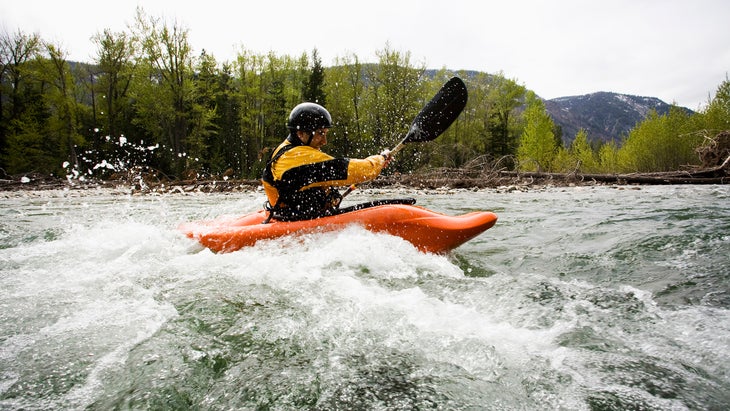
Population 200
Why I Love It
There’s small, and then there’s Mazama, a hamlet in central Washington’s Methow Valley that has less than 200 year-round residents and a “downtown” that’s nothing more than a handful of businesses situated around a junction where two roads meet. But Mazama has everything you need—food, beer, supplies, and a place to sleep.
More importantly, the town is surrounded by the Methow Trails, the largest network of nordic ski trails in the country (120 miles), all of which were created and maintained by a non-profit, also called Methow Trails. During the summer, there’s whitewater rafting on the Methow River, and trad and sport climbing on the Goat Wall, a 1,500-foot tall cliff overlooking the valley. Need more? Mazama is a gateway to North Cascades National Park, which has more glaciers than any park in the lower 48, and also happens to be one of the least visited parks in the country, with under 17,000 visitors last year.
Signature Adventures
State Road 20, a.k.a. North Cascades Highway, closes from Mazama into the park during the winter, but come summer, the two-lane offers a beautiful 90-minute drive west over Washington Pass. The Ross Lake Recreation Area of the park offers the easiest access to Mazama. There, you’ll find three reservoirs of differing shades of milky blue. Grab a canoe ($75 a day) from Ross Lake Resort and explore the lake, which is surrounded by steep, green mountains. Or hike the 3.5-mile Thunder Knob Trail to a prominent point overlooking Diablo Lake.
If you make the trek during winter, cross country skiing is the ticket. There are 120 miles of nordic trails throughout the valley, all of which are groomed nightly. Crazy right? Mazama has its own trailhead, where you can kick and glide along the 11-mile Latte Loop, which has minimal gain but big-valley views.
Where to Eat
There aren’t a lot of options, but the Mazama Store has to-go sandwiches and snacks and is the best example of what a modern general store can be. The Mazama Public House has a taproom and patio with views of Goat Peak, not to mention craft beer, rice bowls, and even sushi.
Where to Stay
The Inn at Mazama has lodge rooms within walking distance of the Public House (from $182 per night).
Fayetteville, West Virginia
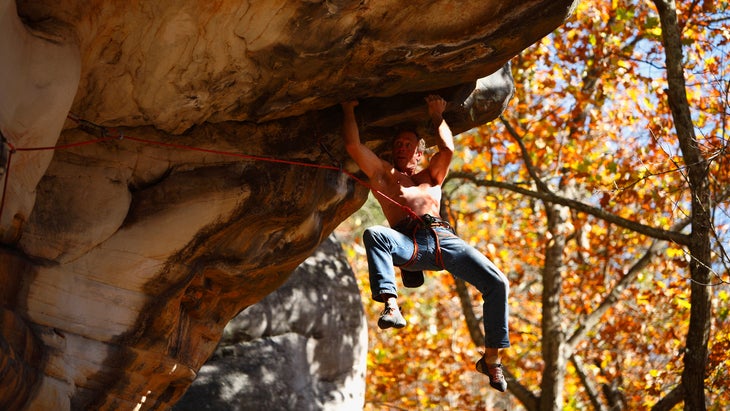
Population 2,900
Why I Love It
In the 1800s, the New River Gorge area attracted lumberjacks and coal miners, as the river canyon was rich in both resources. Now, it attracts hikers, boaters, and climbers, and the New River Gorge has become one of America’s newest national parks.
The small town of Fayetteville has stood witness to it all, evolving into a world-class gateway community with a historic downtown square, and just enough in the way of restaurants and shops to keep visitors and locals satiated. Fayetteville still retains that sleepy, small town vibe, but just beyond the city’s borders lies some of the best outdoor recreation in the East, starting with the whitewater rafting and world-class climbing inside the New River Gorge. There’s also mellow paddling on Summersville Lake, mountain biking on the Arrowhead Trails, a hand-carved system built by Boy Scouts, and more whitewater action on the nearby Gauley River.
Signature Adventures
Most people show up to raft the New River, which runs for 53 miles through the heart of the 1,000-foot deep canyon. The river is typically broken down into two day-long runs. The Upper New is more family friendly, with 13 miles of class I-III rapids, while the Lower New has big hits that reach class IV plus.
The whitewater is exciting, but the climbing is actually better, with more than 1,500 established routes along the sandstone walls that loom over the river below. And that doesn’t even include the growing number of bouldering problems found in the gorge. The climbing isn’t easy (grades top out at 5.15a) but New River Climbing will put you on the right route if you’re looking for a guide (starting at $130 per person).
Where to Eat
Fayetteville’s downtown square sports a handful of restaurants. Operating out of a former church just off the square, Cathedral Cafe has been the town’s go-to for breakfast and lunch for decades. If you ride a couple of hot laps on the flowy Arrowhead Trails, make sure to stop by the Arrowhead Bike Farm for a cold beer and a brat (or taco) served al-fresco in their beer garden.
Where to Stay
The New River Gorge supports several adventure outposts, where you can find cheap campsites or luxury cabins. I like Adventures on the Gorge, which has options spread across a 350-acre campus with its own restaurants, a pool, and a stunning view of the gorge itself (covered platform tent sites start at $49 per night).
McCall, Idaho

Population: 4,066
Why I Love It
The obvious draw to McCall is the skiing. The small town sits in the Cuddy and Salmon River Mountains of Idaho, collecting 300 inches of snow a year, with quick access to three ski resorts, Tamarack Resort, Brundage Mountain, and the aptly named Little Ski Hill, which has night skiing and just a T-bar for a lift.
But then you also have Payette Lake, a 5,000-acre beauty surrounded by green peaks and full of trout that have been beckoning anglers since the 1800s. Not to mention, whitewater rafting on the Middle Fork and Main Fork of the Salmon, and a growing portfolio of mountain bike trails, as well as ample hiking trails in Payette National Forest and Ponderosa State Park. Begin stacking all of these attributes up and it becomes obvious that the draw to McCall is…everything.
Signature Adventures
Many will argue that Brundage Mountain Resort has the best powder in Idaho, so skiers should head there during a winter visit. The mountain has almost 2,000 acres of front-side terrain to explore, but it’s the 18,000 acres of backcountry that you can access via the resort’s cat program that are the real gem here (starting at $575).
Bring your bike in the summer as McCall is rapidly becoming a mountain bike haven, earning a Silver Ride Center designation from IMBA, with a diverse suite of trails that’s rapidly approaching 500 miles large. Head straight for Jug Mountain Ranch, a golf course resort that’s gone all-in on mountain biking with 17 miles of fast, flowy descents, some of which are packed with wooden features, all accessed via easy-to-climb fire roads or shuttle ($30 per rider).
Where to Eat
McCall is a bustling adventure town with plenty of options for a good meal, but Salmon River Brewery has award-winning lagers to go along with their fried wild salmon and chips.
Where to Stay
Scandia Inn takes modern Scandinavian-inspired design and puts it into a 1970s-era motel built with local timber. And the rooms walk out onto an expansive lawn with games and fire pits (from $131 per night).
Bigfork, Montana
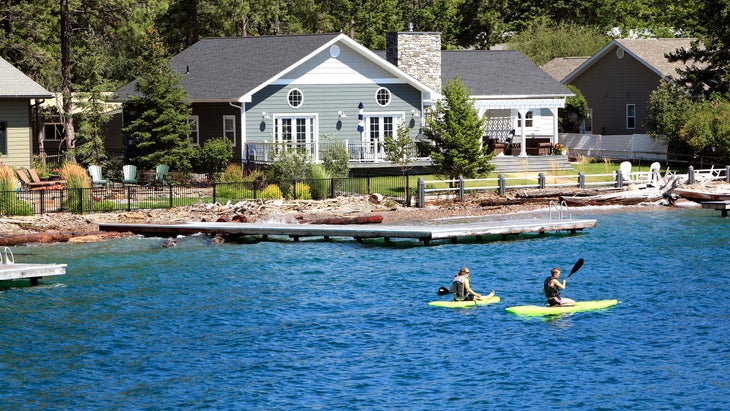
Population: 5,249
Why I Love It
At first glance, Bigfork is a lake town, sitting on the edge of the massive Flathead Lake, which has 200 square miles of water and 185 miles of shoreline. And it has plenty of kayaking and fishing for those that are water inclined. But it’s also a hiking town, with quick access to the Bob Marshall Wilderness, the Flathead National Forest, and numerous state parks.
Want a little adrenaline? Bigfork is also the basecamp for whitewater adventures on the Middle Fork and North Fork of the Flathead River. Oh, and Bigfork is just an hour from the West Glacier entrance to Glacier National Park. So is Bigfork a lake town? Yes, but it’s also so much more.
Signature Adventures
Head to the Jewel Basin Hiking Area of Flathead National Forest, a 15,000-acre tract within the Bob Marshall Wilderness featuring more than 20 alpine lakes. Hike a 6.6-mile loop combining the Mount Aeneas Trail (#717) and the Picnic Lakes Trail to the rocky summit of the 7,000-foot Mount Aeneas, where you’ll find views of the Jewel Basin lakes below, and the ridges of Glacier National Park on the horizon. You’ll occasionally find mountain goats on the summit too. Bring a flyrod and try to land one of the cutthroat or rainbow trout that thrive in the Picnic Lakes on the back end of the loop.
Flathead Lake has six state parks that protect its shoreline and the islands in the middle of the water. Paddle two miles across the lake from the boat launch in Dayton, Montana, to Wild Horse Island, a 2,165-acre state park in the middle of the lake that’s only accessible by boat. Instead of cars, you’ll see feral horses and bighorn sheep. Basecamp Big Fork has kayak and paddleboard rentals (starting at $40).
Where to Eat
Flathead Lake Brewing has views of the lake, 16 beers on tap, and a large pub-food menu that includes a burger topped with jalapeño poppers. So, yeah. Yum.
Where to Stay
Flathead Lake Lodge is an all-inclusive dude ranch on 2,000 acres running along the shores of Flathead Lake. You’ll get access to the property’s 15-mile private mountain bike trail system, canoes, hikes, and horseback rides to backcountry breakfast (starting at $5,103 a week). If you’re looking for less of a financial commitment, Flathead Lake Resort has cabins and Airstreams, all of which come with private access to the lake (from $210 per night).
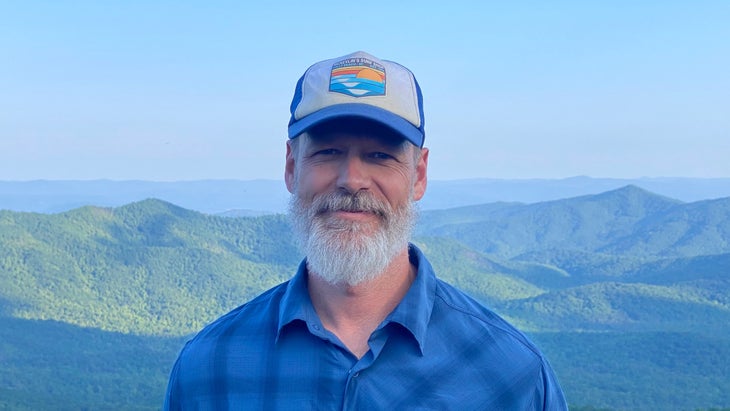
Graham Averill is Outside magazine’s national parks columnist. He’s been lucky enough to live in a few of America’s most fun (and expensive) adventure towns, and recently wrote about the country’s best mountain towns. He also recently wrote about the best national parks for spring break trips.
The post The Top 9 Small Adventure Towns in the U.S. appeared first on Outside Online.















